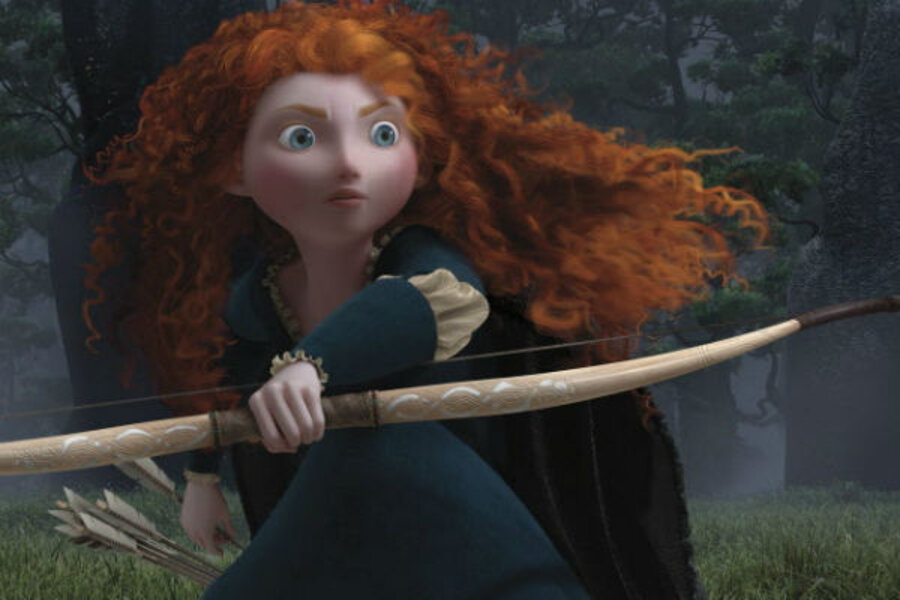‘Brave’: new Disney Princess Merida gets girly Mattel makeover
Loading...
In May, Mattel released a Katniss Everdeen doll, inspired by the look and style of Jennifer Lawrence in "The Hunger Games."
Compared with Mattel’s typical fare, the Katniss doll was refreshingly unsexualized – reflecting the character’s positive portrayal in the film. The Katniss doll is flat-footed (no Barbie-style feet molded for high heels), and she is dressed for battle (not in a gown or dress).
Compared with the typical Barbie doll, Mattel’s Katniss wears very little makeup. Only her eyes seem made up, but the colors are neutral, suggesting this is actually meant as contouring to make the doll’s eyes appear more three-dimensional.
In the beginning of June, Mattel released another doll based on a strong female character: Merida from Disney/Pixar’s "Brave." (The film was released June 22.) Merida is an atypical princess: Like Katniss, she is strong-willed, independent, and a skilled archer.
Unfortunately, unlike Mattel’s Katniss doll, Mattel’s versions of Merida leave much to be desired. Melissa Wardy of the Redefine Girly blog was shopping at Target, and she was shocked by Mattel’s small doll treatment of Merida. The small doll is a 6.5 inches tall, fully plastic doll priced at $5.99. Regarding this doll, Melissa wrote:
"The toy that comes out of the package looks nothing like the character on the package. The toy looks like Merida’s hot older sister, who despite living in the Scottish highlands during medieval times, got her hands on some serious eyeliner and lipstick."
A quick Internet search indicates that Mattel’s other Merida dolls aren’t much better. Their 13-inch fashion doll version is priced at $17.95. You will notice the incredibly long eyelashes, the impeccably groomed eyebrows, the rosebud lips, the gentle expression, and the dainty body language. Also, she is wearing the dress Merida is depicted as hating in the movie, for she is obliged to wear a restrictive corset beneath it.
For a few dollars more ($20.99), Mattel also offers a “Gem Styling Merida Doll,” dressed for archery … and sparkly fashion fun.
The product description on Amazon explains that girls can “decorate Merida’s hair or outfit with sparkly gems,” and that “girls will love reenacting their favorite scenes from the movie.” (Um, sorry, Mattel – there are no gem styling scenes in the movie. Poor Merida!)
Compare these dolls to any image of Merida from the film, and you’ll see that Mattel has feminized Merida, making her much more stereotypically girly and much more conventionally pretty than she is in the film.
Merida is lovely just the way she is. Mascara? Who needs it?
Fortunately, the version of Merida available for $16.50 from the Disney Store is truer to the film’s character. I checked out the products available in my local Disney Store and found them to be preferable to Mattel’s versions.
It has a more focused expression, the crooked smile (also found on the toddler doll), the lighter touch around the eyes, the film-centered accessories. All in all, it’s a nice doll. (I just hope Disney can resist making a super sparkly version.)
In short, a comparison of the different Merida dolls make it clear: Although Mattel designed a Katniss Everdeen doll that reflected the character’s strength and personality, when it came to Merida, Mattel didn’t even try.
But why would that be? Both Katniss and Merida are strong, independent, and enjoy archery – yet their treatments by Mattel couldn’t be more different.
The answer: Just as the films target different audience members, these dolls target different markets, as well.
According to Amazon.com, Mattel’s recommended age for the Merida dolls is “36 months to 8 years.”
Amazon says the recommended age for Mattel’s Katniss doll is 6 to 15. However, according to Barbiecollector.com, the Katniss doll is actually meant for adults. In point of fact, Katniss is from the Black Label line – all of which are described as being meant for adult collectors, ages 14 and up. Katniss’s design was led by one individual, Bill Greening, who describes himself as a "Hunger Games" fan and who approached the design with care.
“Hopefully 'Hunger Games' fans can appreciate the attention to detail,” Greening says. “The doll’s minimalistic style and details – such as her loosely braided hair and makeup-free look – also really embody the heroic character Katniss.”
Fan response has been tremendous: The Katniss doll sold out almost immediately and is now on back order with an expected availability four months from now.
Unfortunately, because Mattel’s "Brave" line is intended for the preschool-to-grade-school set, Merida received no such treatment from Mattel. Presumably designed by committee, the Merida dolls rely on stereotypes about little girls’ interests. Make a little girl’s doll whose face isn’t redesigned to conform to Mattel’s beauty norms? Present a little girl’s doll as strong and independent, rather than dainty and sweet? Nah, that would be much too risky! Mattel clearly believes that long eyelashes and gemstone dress-up activities are a safer marketing bet.
In my opinion, Mattel underestimates little girls. Give them a Merida doll that reflects the movie’s character, and they will love it. Mattel is also blind to why parents have responded positively to the "Brave" trailers: many appreciate that Merida is not a stereotypically princess-like princess.
What a shame that Mattel couldn’t afford young girls who love "Brave" the same respect they afforded to the teens and adults who love "The Hunger Games."
The Christian Science Monitor has assembled a diverse group of the best family and parenting bloggers out there. Our contributing and guest bloggers are not employed or directed by the Monitor, and the views expressed are the bloggers' own, as is responsibility for the content of their blogs. Rebecca Hains blogs at rebeccahains.wordpress.com.








